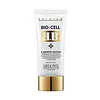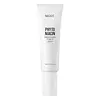What's inside
What's inside
 Key Ingredients
Key Ingredients

 Benefits
Benefits

 Concerns
Concerns

 Ingredients Side-by-side
Ingredients Side-by-side

Water
Skin ConditioningTitanium Dioxide
Cosmetic ColorantDipropylene Glycol
HumectantCyclopentasiloxane
EmollientEthylhexyl Palmitate
EmollientCetyl PEG/PPG-10/1 Dimethicone
EmulsifyingCyclohexasiloxane
EmollientPhenyl Trimethicone
Skin ConditioningHexyl Laurate
EmollientGlycerin
HumectantEthylhexyl Methoxycinnamate
UV AbsorberNiacinamide
SmoothingMagnesium Sulfate
Iron Oxides
Butyrospermum Parkii Butter
Skin ConditioningHydroxyacetophenone
AntioxidantCI 77499
Cosmetic ColorantCI 77491
Cosmetic ColorantSynthetic Fluorphlogopite
Triethoxycaprylylsilane
Tocopheryl Acetate
AntioxidantParfum
MaskingCentella Asiatica Extract
CleansingEthylhexylglycerin
Skin ConditioningAdenosine
Skin ConditioningDisodium EDTA
Allantoin
Skin ConditioningSodium Hyaluronate Crosspolymer
HumectantSodium Hyaluronate
HumectantHydrolyzed Glycosaminoglycans
HumectantHydrolyzed Hyaluronic Acid
HumectantCopper Tripeptide-1
Skin ConditioningAcetyl Hexapeptide-8
HumectantHyaluronic Acid
HumectantOligopeptide-32
AntiseborrhoeicOligopeptide-29
AntioxidantPalmitoyl Pentapeptide-4
Skin ConditioningWater, Titanium Dioxide, Dipropylene Glycol, Cyclopentasiloxane, Ethylhexyl Palmitate, Cetyl PEG/PPG-10/1 Dimethicone, Cyclohexasiloxane, Phenyl Trimethicone, Hexyl Laurate, Glycerin, Ethylhexyl Methoxycinnamate, Niacinamide, Magnesium Sulfate, Iron Oxides, Butyrospermum Parkii Butter, Hydroxyacetophenone, CI 77499, CI 77491, Synthetic Fluorphlogopite, Triethoxycaprylylsilane, Tocopheryl Acetate, Parfum, Centella Asiatica Extract, Ethylhexylglycerin, Adenosine, Disodium EDTA, Allantoin, Sodium Hyaluronate Crosspolymer, Sodium Hyaluronate, Hydrolyzed Glycosaminoglycans, Hydrolyzed Hyaluronic Acid, Copper Tripeptide-1, Acetyl Hexapeptide-8, Hyaluronic Acid, Oligopeptide-32, Oligopeptide-29, Palmitoyl Pentapeptide-4
Water
Skin ConditioningButylene Glycol
HumectantGlycerin
HumectantDimethicone
EmollientCyclopentasiloxane
EmollientTitanium Dioxide
Cosmetic ColorantNiacinamide
SmoothingPanthenol
Skin ConditioningSodium Polyacrylate
AbsorbentEthylhexyl Stearate
EmollientSodium Acrylate/Sodium Acryloyldimethyl Taurate Copolymer
Emulsion StabilisingIsohexadecane
EmollientDimethiconol
EmollientTrideceth-6
EmulsifyingTriethoxycaprylylsilane
Aluminum Hydroxide
EmollientAdenosine
Skin ConditioningPolysorbate 80
EmulsifyingDisodium EDTA
Sorbitan Oleate
EmulsifyingCamellia Japonica Seed Oil
EmollientCeramide NP
Skin ConditioningAllantoin
Skin ConditioningCitrus Paradisi Fruit Extract
Skin ConditioningBambusa Vulgaris Extract
Skin ConditioningCentella Asiatica Extract
CleansingPentylene Glycol
Skin Conditioning1,2-Hexanediol
Skin ConditioningAnthemis Nobilis Flower Extract
MaskingCaprylyl Glycol
EmollientMadecassoside
AntioxidantBeta-Glucan
Skin ConditioningPalmitoyl Tripeptide-5
Skin ConditioningCopper Tripeptide-1
Skin ConditioningWater, Butylene Glycol, Glycerin, Dimethicone, Cyclopentasiloxane, Titanium Dioxide, Niacinamide, Panthenol, Sodium Polyacrylate, Ethylhexyl Stearate, Sodium Acrylate/Sodium Acryloyldimethyl Taurate Copolymer, Isohexadecane, Dimethiconol, Trideceth-6, Triethoxycaprylylsilane, Aluminum Hydroxide, Adenosine, Polysorbate 80, Disodium EDTA, Sorbitan Oleate, Camellia Japonica Seed Oil, Ceramide NP, Allantoin, Citrus Paradisi Fruit Extract, Bambusa Vulgaris Extract, Centella Asiatica Extract, Pentylene Glycol, 1,2-Hexanediol, Anthemis Nobilis Flower Extract, Caprylyl Glycol, Madecassoside, Beta-Glucan, Palmitoyl Tripeptide-5, Copper Tripeptide-1
Ingredients Explained
These ingredients are found in both products.
Ingredients higher up in an ingredient list are typically present in a larger amount.
Adenosine is in every living organism. It is one of four components in nucleic acids that helps store our DNA.
Adenosine has many benefits when used. These benefits include hydrating the skin, smoothing skin, and reducing wrinkles. Once applied, adenosine increases collagen production. It also helps with improving firmness and tissue repair.
Studies have found adenosine may also help with wound healing.
In skincare products, Adenosine is usually derived from yeast.
Learn more about AdenosineAllantoin is a soothing ingredient known for its protective and moisturizingg properties. Because of this, it is often added to products with strong active ingredients.
Studies show higher concentrations of this ingredient can promote wound healing.
Though it can be derived from the comfrey plant, allantoin is produced synthetically for cosmetic products to ensure purity.
Learn more about AllantoinCentella Asiatica Extract (Centella) is derived from an herb native to Southeast Asia. It is famous for its anti-inflammatory and soothing properties.
Centella is rich in antioxidants and amino acids, such as Madecassic Acid and Asiaticoside.
Studies show the compounds in centella help with:
The combination of all these properties makes centella effective at soothing, hydrating, and protecting the skin.
Other great components of centella include Vitamin A, vitamin C, several B vitamins, and Asiatic Acid.
Fun fact: Centella has been used as a medicine and in food for many centuries. As a medicine, it is used to treat burns, scratches, and wounds.
Learn more about Centella Asiatica ExtractCopper Tripeptide-1 (GHK-Cu) is a skin repairing ingredient known for its ability to boost collagen, improve firmness, and support skin regeneration.
It is a complex made up of a naturally occurring peptide (glycine-histidine-lysine) and copper, an essential trace element.
While studying wound healing, researchers noticed GHK-Cu stimulated hair follicle enlargement and growth by keeping hair in its active growth phase longer. This has made it a promising ingredient for hair regrowth treatments.
Some people have reported increased facial hair. While GHK-Cu can make your hair follicles bigger, it usually doesn’t turn soft, barely-visible facial hairs into thick, dark ones.
Anecdotal reports suggest that overusing copper peptides might lead to premature aging due to excess free copper or enzyme imbalances. This claim isn’t backed by large-scale studies.
Unfortunately, there are limited human studies for this ingredient. While early results are promising, many studies are either small, in-vitro, or not rigorously controlled.
For example, there is a 1998 study that explored the effects of copper tripeptide, vitamin C, tretinoin, and melatonin on skin repair and collagen synthesis.
After one month, increased procollagen production was seen in 7 out of 10 participants using copper tripeptide (more than those using vitamin C, melatonin, or tretinoin.
While the study was exploratory, it offers early evidence that copper tripeptide may support collagen production. Larger, well-designed trials are still needed to confirm its potential and understand individual responses.
Read more about other common types of peptides here:
Learn more about Copper Tripeptide-1Cyclopentasiloxane, or D5, is a silicone used to improve texture of products and trap moisture.
D5 is considered lightweight and volatile. Volatile means it evaporates quickly after application. Once evaporated, D5 leaves a thin barrier that helps keep skin hydrated.
It is also an emollient. Emollients help soften the skin and prevent water loss. Silicones create a silky texture in products. D5 helps other ingredients become more spreadable.
Studies show D5 is safe to use in skincare products. We recommend speaking with a skincare professional if you have concerns.
Learn more about CyclopentasiloxaneDisodium EDTA plays a role in making products more stable by aiding other preservatives.
It is a chelating agent, meaning it neutralizes metal ions that may be found in a product.
Disodium EDTA is a salt of edetic acid and is found to be safe in cosmetic ingredients.
Learn more about Disodium EDTAGlycerin is already naturally found in your skin. It helps moisturize and protect your skin.
A study from 2016 found glycerin to be more effective as a humectant than AHAs and hyaluronic acid.
As a humectant, it helps the skin stay hydrated by pulling moisture to your skin. The low molecular weight of glycerin allows it to pull moisture into the deeper layers of your skin.
Hydrated skin improves your skin barrier; Your skin barrier helps protect against irritants and bacteria.
Glycerin has also been found to have antimicrobial and antiviral properties. Due to these properties, glycerin is often used in wound and burn treatments.
In cosmetics, glycerin is usually derived from plants such as soybean or palm. However, it can also be sourced from animals, such as tallow or animal fat.
This ingredient is organic, colorless, odorless, and non-toxic.
Glycerin is the name for this ingredient in American English. British English uses Glycerol/Glycerine.
Learn more about GlycerinNiacinamide is a multitasking form of vitamin B3 that strengthens the skin barrier, reduces pores and dark spots, regulates oil, and improves signs of aging.
And the best part? It's gentle and well-tolerated by most skin types, including sensitive and reactive skin.
You might have heard of "niacin flush", or the reddening of skin that causes itchiness. Niacinamide has not been found to cause this.
In very rare cases, some individuals may not be able to tolerate niacinamide at all or experience an allergic reaction to it.
If you are experiencing flaking, irritation, and dryness with this ingredient, be sure to double check all your products as this ingredient can be found in all categories of skincare.
When incorporating niacinamide into your routine, look out for concentration amounts. Typically, 5% niacinamide provides benefits such as fading dark spots. However, if you have sensitive skin, it is better to begin with a smaller concentration.
When you apply niacinamide to your skin, your body converts it into nicotinamide adenine dinucleotide (NAD). NAD is an essential coenzyme that is already found in your cells as "fuel" and powers countless biological processes.
In your skin, NAD helps repair cell damage, produce new healthy cells, support collagen production, strengthen the skin barrier, and fight environmental stressors (like UV and pollution).
Our natural NAD levels start to decline with age, leading to slower skin repair, visible aging, and a weaker skin barrier. By providing your skin niacinamide, you're recharging your skin's NAD levels. This leads to stronger, healthier, and younger looking skin.
Another name for vitamin B3 is nicotinamide. This vitamin is water-soluble and our bodies don't store it. We obtain Vitamin B3 from either food or skincare. Meat, fish, wheat, yeast, and leafy greens contain vitamin B3.
The type of niacinamide used in skincare is synthetically created.
Learn more about NiacinamideTitanium dioxide is a mineral UV filter widely used in sunscreens and cosmetics.
It is one of only two UV filters officially classified as “mineral” by regulatory agencies, the other being zinc oxide.
Titanium dioxide provides broad-spectrum protection mostly in the UVB and UVAII range, with some protection in the UVAI range.
While its UVA protection isn’t as strong as zinc oxide’s, the difference is minor.
A common myth is that mineral UV filters reflect UV light. However, modern research shows titanium dioxide absorbs UV radiation like chemical filters (~95% absorption & 5% reflection).
Thanks to its non-irritating nature, titanium dioxide is suitable for sensitive, acne-prone, or redness-prone skin. It is unlikely to cause "eye sting" like other sunscreen ingredients.
A major drawback of this ingredient is its white cast and thick texture. This is why mineral sunscreens often leave a white cast and are less cosmetically elegant than chemical/hybrid sunscreens.
To improve white cast and spreadability, micronized or nano-sized titanium dioxide is often used.
There are ongoing concerns surrounding nano-titanium oxide's impact on marine ecosystems.
There is no conclusive evidence that any form of titanium oxide (or any other sunscreen ingredients) will cause harm to marine ecosystems or coral reefs. The science is still developing but many consumers are keeping a close eye on this issue.
Please note, many destinations have reef-safety sunscreen rules. For instance, the U.S. Virgin Islands advises all visitors to use non-nano mineral sunscreens.
Nano mineral sunscreens once raised safety concerns about absorption into skin.
Extensive research has shown that they do not penetrate healthy or damaged skin; they remain safely on the surface and the top layer of dead skin (stratum corneum).
You'll likely find titanium dioxide bundled with alumina, silica, or dimethicone. These ingredients help make titanium dioxide highly photostable; this prevents it from interacting with other formula components under UV light.
Learn more about Titanium DioxideTriethoxycaprylylsilane is a silicone used to bind and stabilize ingredients.
As an emulsifier, it helps prevent ingredients from separating. This can help elongate the shelf life of products.
Triethoxycaprylylsilane is often used to coat mineral sunscreens ingredients to help give a better feel. It also helps reduce oxidative stress in sunscreens.
Learn more about TriethoxycaprylylsilaneWater. It's the most common cosmetic ingredient of all. You'll usually see it at the top of ingredient lists, meaning that it makes up the largest part of the product.
So why is it so popular? Water most often acts as a solvent - this means that it helps dissolve other ingredients into the formulation.
You'll also recognize water as that liquid we all need to stay alive. If you see this, drink a glass of water. Stay hydrated!
Learn more about Water